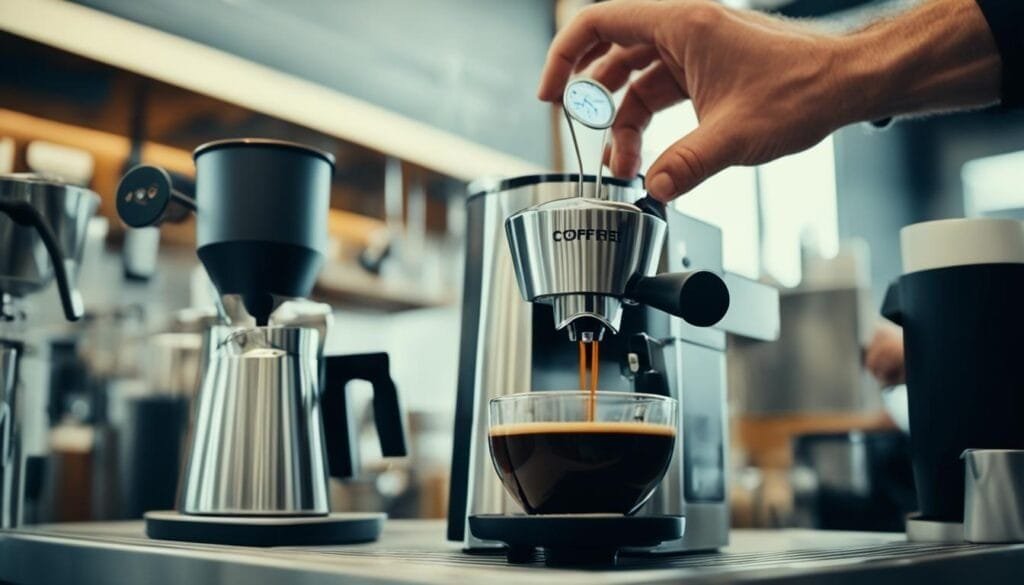Did you know that there are over 800 flavor profiles in espresso alone? From rich chocolatey notes to bright citrusy flavors, each sip of espresso holds a world of taste waiting to be explored. Embark on a journey of sensory discovery with advanced espresso tasting techniques that will unlock the hidden depths in every cup.
Key Takeaways:
- Master the art of espresso sensory evaluation to dive deeper into the world of coffee flavors.
- Learn advanced coffee palate training techniques to develop a sophisticated coffee palate.
- Discover specialty coffee tasting methods such as cupping to explore the unique characteristics of different coffees.
Dialing in Like a Pro
Dialing in your espresso is the art of fine-tuning to achieve the perfect extraction and flavor. By making micro adjustments in grind size, dose, and shot time, you can unlock the full potential of your coffee beans. Additionally, proper grinder calibration and using your taste as a compass are crucial in producing exceptional espresso.
“Dialing in is all about finding that sweet spot where your coffee tastes its best.”
To start, let’s talk about grind size. The fineness or coarseness of your coffee grounds significantly affects the extraction process. A finer grind yields a slower extraction, resulting in a more intense and robust flavor. Conversely, a coarser grind promotes a faster extraction, producing a lighter and fruitier profile. It’s essential to experiment with different grind sizes to discover the optimal one that suits your taste preferences.
Next, let’s delve into the dose, which refers to the amount of coffee used for a single shot. Adjusting the dose can influence the strength and body of your espresso. A higher dose produces a bolder and more concentrated shot, while a lower dose creates a milder and more balanced cup. It’s worth noting that the dose should be adjusted in conjunction with the grind size to achieve the desired extraction and flavor.
Shot time is another critical factor in dialing in your espresso. It refers to the duration of the extraction process. Generally, a shot time between 25 to 30 seconds is considered ideal, but this can vary depending on the coffee beans and desired flavor profile. A shorter shot time may result in under-extracted flavors, while a longer shot time can lead to over-extraction and unpleasant bitter notes. Remember to monitor shot time closely during the brewing process.
Grinder calibration is an often overlooked aspect of dialing in espresso. Ensuring your grinder is properly calibrated allows for consistent particle size distribution, resulting in more predictable extractions. Regularly cleaning and calibrating your grinder helps maintain its performance and guarantees accurate grind settings.
Using Taste as Your Compass
Taste-driven decisions are at the heart of dialing in your espresso. While variables like grind size, dose, and shot time provide a starting point, it’s ultimately your palate that acts as the guide. By tasting your espresso throughout the brewing process, you can make informed adjustments and fine-tune until you reach the desired flavor profile.
Key Takeaways
- Experiment with different grind sizes to find the optimal extraction and flavor.
- Adjust the dose according to your desired strength and body.
- Monitor shot time for the ideal extraction duration.
- Regularly clean and calibrate your grinder to ensure consistent performance.
- Let your taste buds guide you in making precise adjustments to achieve the perfect espresso extraction.
Mastering the art of dialing in requires practice, patience, and taste-driven decisions. As you become more familiar with the intricacies of espresso extraction, you’ll develop a keen sense of how subtle changes in variables impact the final cup. So get ready to embark on a flavor-filled journey as you use taste as your compass to brew extraordinary espresso.
Distribution Techniques
Proper distribution techniques are crucial for achieving even extraction and a balanced flavor in your espresso. Uneven distribution can result in channeling, where some areas of the coffee puck are over-extracted while others are under-extracted, leading to an inconsistent and undesirable taste.
One popular distribution technique used by coffee professionals is the Stockfleth’s technique. This method involves swirling the coffee grounds in the portafilter to achieve uniformity and eliminate clumps. By distributing the grounds evenly, you ensure that the water flows through the puck in a consistent manner, extracting the desired flavors and preventing any channels.
“The Stockfleth’s technique is a simple yet effective way to improve the extraction and flavor of your espresso. It helps distribute the grounds evenly, ensuring a more balanced and delicious shot.”
How to Perform the Stockfleth’s Technique:
- Start by dosing your coffee into the portafilter. Use the back of a spoon or distribution tool to level the grounds.
- Place the portafilter on a flat surface and hold it at a 45-degree angle.
- Begin swirling the portafilter in a circular motion, gently shaking it to distribute the coffee evenly.
- Continue swirling for a few seconds until you achieve a smooth, flat surface of coffee.
- Tap the portafilter lightly on the surface to settle the grounds.
- Your coffee puck is now evenly distributed and ready for tamping.
By adopting proper distribution techniques like the Stockfleth’s technique, you can enhance the consistency and quality of your espresso extractions. The result will be a more balanced and flavorful cup of coffee that truly showcases the unique characteristics of your beans.
| Distribution Techniques | Benefits |
|---|---|
| Stockfleth’s Technique | – Achieves uniformity in coffee distribution – Prevents channeling and uneven extraction – Enhances flavor consistency |
| WDT (Weiss Distribution Technique) | – Helps break up clumps and ensure even distribution – Improves extraction and flavor balance – Minimizes the risk of channelling |
| Finger Tapping | – Releases trapped air in the coffee grounds – Promotes even distribution – Reduces the chance of channeling |
Mastering Pressure Profiling
Pressure profiling is a game-changer in the world of espresso brewing. It allows you to take complete control over the pressure applied during the extraction process, resulting in a more refined and customized flavor profile. By manipulating the pressure, you can extract the core flavors of your coffee and unlock a world of taste possibilities.
One key technique in pressure profiling is the use of soft pre-infusion. This involves gently saturating the coffee puck with water at a lower pressure before ramping up the pressure for the full extraction. Soft pre-infusion ensures even saturation, mitigating the risk of over-extraction and extracting the delicate nuances of the coffee. The result is a well-balanced espresso that showcases the core flavors and complexities of the beans.
But pressure profiling is not just about even saturation. It also allows you to experiment with different pressure curves to further enhance your espresso. By building up the pressure gradually or applying varying levels of pressure at different stages, you can create unique flavor profiles tailored to your taste preferences.
Here’s a table that visually presents the impact of pressure profiling on the extraction process:
| Pressure Profile | Extraction Result |
|---|---|
| Constant low pressure | Under-extracted espresso with light body and acidity |
| Gradual pressure ramp-up | Well-rounded espresso with balanced acidity and sweetness |
| Variable pressure curves | Complex espresso with layered flavors and a long finish |
As you can see, pressure profiling offers endless possibilities to tease out different flavors and create truly exceptional espresso. Experiment with different profiles, take notes, and refine your technique to achieve the perfect extraction every time.

Temperature Surfing
Water temperature is a crucial element in the art of espresso extraction. Managing the temperature fluctuations in your espresso machine is essential to achieving consistent flavor and unlocking the full potential of your coffee beans. This technique, known as temperature surfing, allows you to navigate the changing thermal conditions during the brewing process.
Temperature surfing involves a delicate balance of timing and expertise, ensuring that the water temperature remains within the ideal range for extracting the desired flavors. By actively monitoring and adjusting the temperature, you can influence the taste profile of your espresso shot and create a more engaged brewing process.
To embark on your temperature surfing journey, begin by understanding the optimal water temperature for espresso extraction. While it can vary depending on the coffee beans and personal preferences, a general range of 195°F to 205°F (90°C to 96°C) is commonly recommended by coffee experts. This range allows for the extraction of the desired flavors while minimizing the risk of over-extraction or under-extraction.
Now, let’s explore the step-by-step process of temperature surfing:
- Start by preheating your espresso machine, ensuring it reaches the desired brewing temperature.
- Flush a small amount of water through the group head and portafilter to remove any residual heat or coffee particles.
- Allow the temperature to drop slightly before dosing your coffee grounds into the portafilter.
- Begin the extraction process, monitoring the temperature as the water passes through the coffee puck.
- Make adjustments to the brewing time or flow rate to maintain the desired water temperature within the optimal range.
- Continue to monitor and fine-tune the temperature throughout the extraction, ensuring consistency and flavor balance.
With practice and experimentation, temperature surfing can become second nature, enhancing your ability to craft exceptional espresso shots. Remember to document your findings and observations, noting the variations in flavor and nuances brought about by different temperature profiles. By mastering this technique, you’ll be able to consistently produce espresso with a consistent flavor profile, offering a truly extraordinary sensory experience.

Advanced Tamping Techniques
Tamping is a critical step in achieving even extraction in espresso. Proper tamping ensures that the coffee grounds are evenly distributed and compacted, allowing for a consistent and flavorful extraction. In this section, we will explore two advanced tamping techniques that can elevate your espresso game: the nutation technique and variable pressure tamping.
The Nutation Technique
The nutation technique involves a slight swirling motion during tamping, ensuring an even distribution of coffee grounds in the portafilter. By gently rotating the tamper in a circular motion, you create a uniform and level puck, maximizing the surface area for water to extract flavors.
Unlike the traditional vertical tamping method, which can sometimes result in uneven extraction, the nutation technique helps combat micro-channels. These micro-channels, tiny gaps or pathways in the puck, can lead to inconsistent extraction and affect the overall taste of your espresso. By swirling the tamper, you ensure that the coffee grounds are evenly distributed, minimizing the formation of micro-channels and promoting even extraction.
To apply the nutation technique, follow these steps:
- Fill the portafilter with the desired amount of coffee grounds.
- Hold the tamper in a vertical position, resting it on the coffee grounds.
- Apply downward pressure while simultaneously rotating the tamper in a circular motion.
- Continue tamping until you feel resistance from the compacted coffee grounds.
By incorporating the nutation technique into your tamping routine, you can achieve a more consistent and balanced extraction, resulting in a flavorful espresso shot.
Variable Pressure Tamping
Variable pressure tamping involves applying different levels of pressure during the tamping process. This technique helps combat micro-channels and ensures an even extraction throughout the coffee puck.
Micro-channels can occur when water finds paths of least resistance through the coffee grounds, leading to uneven extraction and an imbalanced flavor profile. By varying the pressure applied during tamping, you can disrupt the formation of these micro-channels and achieve a more uniform extraction.
Here’s how to perform variable pressure tamping:
- Start with a gentle initial tamp to ensure the coffee grounds are level and evenly distributed.
- Gradually increase the pressure as you continue the tamping process. Apply firm pressure towards the end of the tamp.
- Ensure that the pressure is consistent across the entire puck, avoiding uneven tamping.
- Finish with a final, gentle press to compress the grounds and create a level surface.
Variable pressure tamping allows for greater control over the extraction process, producing a more consistent and balanced espresso shot.
By incorporating the nutation technique and variable pressure tamping into your espresso routine, you can combat micro-channels, achieve even extraction, and produce exceptional espresso shots with enhanced flavor profiles.
| Tamping Technique | Description |
|---|---|
| The Nutation Technique | A slight swirling motion during tamping to ensure even grounds distribution and combat micro-channels. |
| Variable Pressure Tamping | The application of different levels of pressure during tamping to achieve an even extraction and prevent micro-channels. |
Exploring Different Brew Ratios
Adjusting the brew ratio, the proportion of coffee to water, is a key factor in crafting the perfect espresso with your desired flavor profile. This is where you can truly unlock the potential of your espresso and create unique taste experiences.
Each brew ratio brings out different characteristics in the coffee, allowing you to tailor your espresso to your preferences. By experimenting with different brew ratios, you can discover a wide range of flavors, from bold and concentrated shots to balanced and nuanced ones.
For those who enjoy a bold and strong espresso, a higher coffee-to-water ratio can deliver that rich intensity. By using a larger amount of coffee grounds relative to the water, you enhance the boldness and create a more pronounced flavor in your cup.
On the other hand, if you prefer a more balanced and nuanced espresso, a lower brew ratio can help achieve that. This ratio allows the flavors of the coffee to shine through while maintaining a pleasant balance between sweetness, acidity, and bitterness.
To give you a better understanding of how different brew ratios can impact the flavor profile, here’s a table showcasing some common brew ratios and their corresponding characteristics:
| Brew Ratio | Characteristics |
|---|---|
| 1:1 | A bold, intense espresso with a heavy body and concentrated flavors. |
| 1:2 | A balanced espresso with a good mix of body, sweetness, and acidity. |
| 1:3 | A bright and vibrant espresso with pronounced acidity and delicate flavors. |
| 1:4 | A lighter, delicate espresso with subtle flavors and a clean finish. |
Keep in mind that these brew ratios are just starting points, and you can further fine-tune them to suit your taste preferences. Don’t be afraid to experiment and explore different ratios to find the perfect balance for your desired flavor profile.
So go ahead, grab your coffee beans and brewing equipment, and embark on an exciting journey of discovering the endless possibilities that different brew ratios offer. Unleash your creativity and elevate your espresso game to new heights!
Conclusion
The future of quality espresso extraction lies in combining sensory skills with measurable variables. In order to create the perfect shot of espresso, it is crucial to understand key factors such as dose, grind, and time. Additionally, mastering techniques such as distribution, pressure profiling, tamping, and temperature surfing will elevate your coffee brewing skills to new heights.
Experimentation and calibration are essential in consistently producing delicious espresso. By using your taste as a guide, you can fine-tune your recipes and create a personalized brewing method that suits your preferences. With practice, you will develop sensory skills that allow you to detect subtle flavor notes and make real-time adjustments to your brewing process.
Remember, coffee brewing is a journey that requires continuous learning and refinement. Stay curious, explore different extraction techniques, and always strive for excellence. By incorporating these espresso techniques into your routine, you can hone your sensory skills, master the measurable variables, and create espresso that is truly exceptional. Happy brewing!
FAQ
What are advanced espresso tasting techniques?
Advanced espresso tasting techniques involve evaluating espresso flavor profiles, developing a sophisticated coffee palate, and conducting sensory evaluations through specialty coffee cupping methods.
How do I dial in my espresso like a pro?
Dialing in your espresso involves making micro adjustments in grind size, dose, and shot time to find the ideal extraction. Use your taste as a compass and make taste-driven decisions. Calibrating your grinder is also essential for consistent results.
What are distribution techniques in espresso brewing?
Distribution techniques ensure even extraction and prevent channeling in the coffee puck. The Stockfleth’s technique is a popular method that involves swirling the grounds in the portafilter to achieve uniformity and eliminate clumps.
How can I master pressure profiling in espresso extraction?
Pressure profiling allows for dynamic adjustments in brewing pressure during extraction. Soft pre-infusion, where water gently permeates the coffee puck, helps achieve even saturation. Building up pressure gradually extracts core flavors and offers versatility in altering the flavor profile.
What is temperature surfing in espresso brewing?
Temperature surfing involves navigating thermal fluctuations in espresso machines to maintain the ideal brewing temperature. This technique ensures consistent flavor in your espresso and deepens your connection to the brewing process.
What are advanced tamping techniques for even extraction?
Advanced tamping techniques like nutation involve a slight swirling motion during tamping to ensure even distribution of the grounds. Variable pressure tamping, where different pressures are applied, helps combat micro-channels and achieve a more uniform extraction.
How can I explore different brew ratios in espresso brewing?
Adjusting the brew ratio, the proportion of coffee to water, can impact the flavor profile of your espresso. Different brew ratios can bring out different flavors in the coffee, from bold and concentrated shots to balanced and nuanced ones. Experimenting with brew ratios can help you discover new taste experiences.
What is the importance of developing sensory skills and measurable variables in coffee brewing?
Developing sensory skills and understanding measurable variables such as dose, grind, and time is crucial for producing consistently delicious espresso. Recipe calibration and using your taste as a guide empower you to create the perfect shot of espresso.
Source Links
- https://www.foxcoffee.com.au/blogs/blog/advanced-espresso-techniques-with-fox-coffee-taking-your-barista-skills-to-the-next-level
- https://medium.com/@SteveSpring/the-art-of-espresso-compare-the-best-techniques-and-tips-7735241290bb
- https://www.beanscenemag.com.au/advanced-calibration-different-stages-espresso-extraction/




